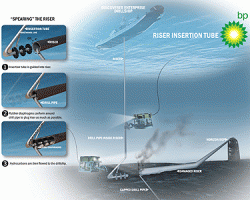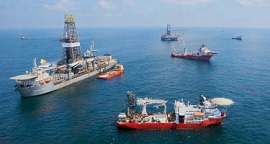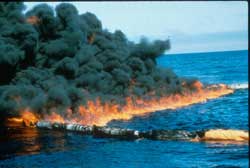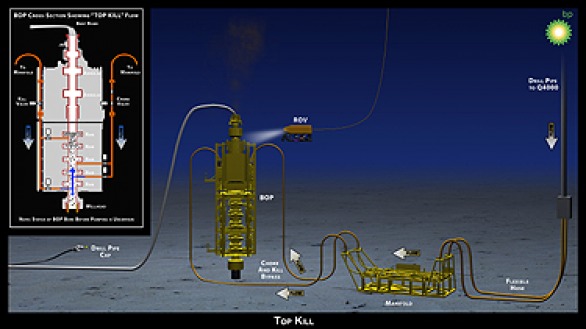Crude Oil Spill Control, Cleanup, Remediation Facts
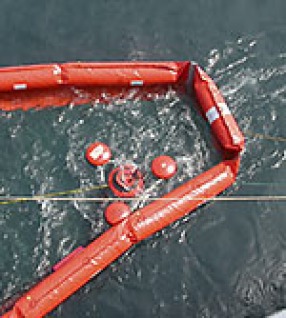
Oil Boom at Oil Rig Drilling Site
Accidental spills, leaks, or explosions of crude oil vessels or rigs are dangerous events that require rapid corrective actions. Oil accidents and spills, such as BP's Deepwater Horizon site at Mississippi Canyon in the Gulf of Mexico, can have immediate and long-term effects on water and land resources. Here is a list of crude oil, post-spill, control-cleanup procedures and facts.
Crude Oil Spills – Steps and Facts for Control, Cleanup and Remediation
Important, valuable and useful steps for the control of oil spills include:
1. Oil seals, caps, or domes and cut and cap procedures are used to stop leaking or spilled oil at the source. Undersea robots are used in deepwater situations to accomplish tasks which are impossible for humans. Early control and cleanup responses minimize oil damage and reduce time, labor and expenses for remediation.
2. RITT or riser insertion tube tools can partially block, trap, and capture escaping oil and gas at an oil accident and release site. Captured oil and gas is transferred to a receiving vessel on the surface. The gas is flared or burned (see drillship flaring of captured gas).
3. Top kill procedures are employed to choke off crude oil flow at the containment valve site. The pipe is flooded with a large mass of debris (a junk shot that includes pieces of tires, rope, golf balls and assorted other materials) to choke off the oil flow. Next, oil pipe stuffing or filling with massive amounts of mud are introduced and this followed by large amounts of hydraulic cement to effect a seal.
4. Oil booms (floating barriers) are used for control and containment of surface oils. Skimming of boom oils or burns, or both, may be used.
5. Oil Skimming and capture of large masses of surface oils onto recovery tanker ships for transfer to refineries and subsequent commercial use.
6. Dispersant chemical addition to break up oil that cannot be boom-managed, skimmed, sipped or burned.
7. Oil-eating bacteria and microbe seeding and addition to oil. These bacteria digest and breakdown oil and remove many fractions of the crude oil mixture.
8. Relief well drilling permits relieving pressure from the damaged well and pipe site, and this relief well permits oil retrieval and relief of pressure at the damaged site. Alternatively, total closure of the entire oil bed is possible once the relief well is completed.
Finding and drilling for oil in deep waters is a difficult task in itself. Accidents at drill sites that release massive amounts of oil are extremely problematic. Read more about crude oil spill dangers at the biological, chemical and medical levels.
Sources
BP: The response in detail (Gulf of Mexico Response) http://www.bp.com/sectiongenericarticle.do?categoryId=9033573&contentId=7061702 accessed, May 19, 2010.
NOAA, National Oceanographic and Atmospheric Association, U.S: http://www.noaa.gov/.
VISIT Our Science Super School Store
Crude Oil Spills – Steps and Facts for Control, Cleanup and Remediation
Important, valuable and useful steps for the control of oil spills include:
1. Oil seals, caps, or domes and cut and cap procedures are used to stop leaking or spilled oil at the source. Undersea robots are used in deepwater situations to accomplish tasks which are impossible for humans. Early control and cleanup responses minimize oil damage and reduce time, labor and expenses for remediation.
2. RITT or riser insertion tube tools can partially block, trap, and capture escaping oil and gas at an oil accident and release site. Captured oil and gas is transferred to a receiving vessel on the surface. The gas is flared or burned (see drillship flaring of captured gas).
3. Top kill procedures are employed to choke off crude oil flow at the containment valve site. The pipe is flooded with a large mass of debris (a junk shot that includes pieces of tires, rope, golf balls and assorted other materials) to choke off the oil flow. Next, oil pipe stuffing or filling with massive amounts of mud are introduced and this followed by large amounts of hydraulic cement to effect a seal.
4. Oil booms (floating barriers) are used for control and containment of surface oils. Skimming of boom oils or burns, or both, may be used.
5. Oil Skimming and capture of large masses of surface oils onto recovery tanker ships for transfer to refineries and subsequent commercial use.
6. Dispersant chemical addition to break up oil that cannot be boom-managed, skimmed, sipped or burned.
7. Oil-eating bacteria and microbe seeding and addition to oil. These bacteria digest and breakdown oil and remove many fractions of the crude oil mixture.
8. Relief well drilling permits relieving pressure from the damaged well and pipe site, and this relief well permits oil retrieval and relief of pressure at the damaged site. Alternatively, total closure of the entire oil bed is possible once the relief well is completed.
Finding and drilling for oil in deep waters is a difficult task in itself. Accidents at drill sites that release massive amounts of oil are extremely problematic. Read more about crude oil spill dangers at the biological, chemical and medical levels.
Sources
BP: The response in detail (Gulf of Mexico Response) http://www.bp.com/sectiongenericarticle.do?categoryId=9033573&contentId=7061702 accessed, May 19, 2010.
NOAA, National Oceanographic and Atmospheric Association, U.S: http://www.noaa.gov/.
VISIT Our Science Super School Store
All the Written Material within Site is Copyrighted 2010 and Owned by Dr. Donald Reinhardt, and this original material is protected legally by this copyright notice and by the Digital Millennium Act. None of this original material may be copied or reproduced without the expressed written consent of the author.
The author is a Freelance Science writer, and is available for specific assignments for those who are interested – by contacting adminstrator@sciencesuperchool.com. Other questions related to this teaching site should be directed to teacher@sciencesuperschool.com.
The author is a Freelance Science writer, and is available for specific assignments for those who are interested – by contacting adminstrator@sciencesuperchool.com. Other questions related to this teaching site should be directed to teacher@sciencesuperschool.com.
